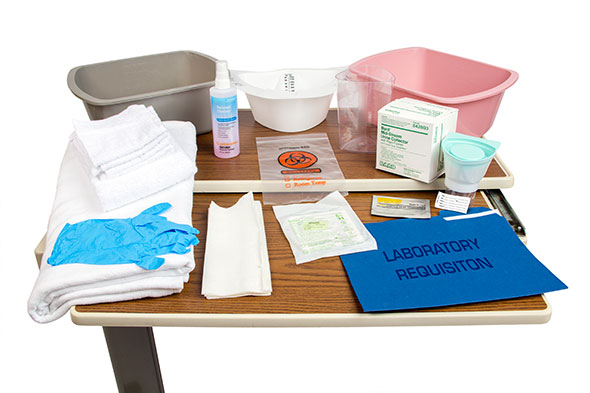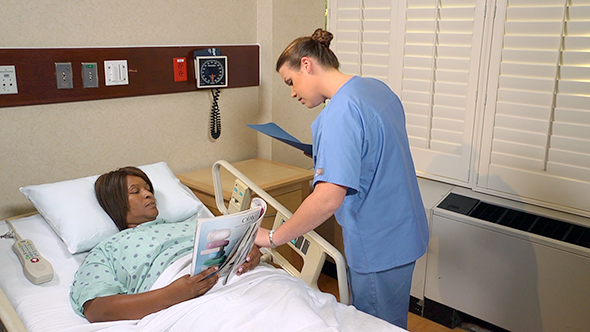Specimen Collection and Surgical Care
Select a Skill:
- » Collecting a Midstream Specimen
- » Collecting a 24-Hour Urine Specimen
- » Collecting and Testing a Stool Specimen
- » Collecting a Sputum Specimen
- » Measuring Blood Glucose
- » The Surgical Skin Prep—Shaving the Skin
- » Assisting with Deep Breathing and Coughing Exercises
Take the Review Test:

Purpose

- Urine specimens are collected for urine tests.
- A midstream specimen is also called a clean-voided specimen or clean-catch specimen. The perineal area is cleaned before collecting the specimen. This reduces the number of microbes in the urethral area. The person starts to void into a device. Then the person stops the urine stream, and a sterile specimen container is positioned. The person voids into the container until the specimen is obtained.
- Stopping the urine stream is hard for many people. You may need to position and hold the specimen container in place after the person starts to void.
- Follow these rules for collecting urine specimens:
- Follow the rules of medical asepsis.
- Use a clean container for each specimen. Use the correct container.
- Do not touch the inside of the container or lid.
- Label the container in the person’s presence. Provide clear, accurate information.
- Collect the specimen at the correct time.
- Ask a female if she is menstruating. Tell the nurse. Menstruation may cause blood to be in the urine specimen.
- Instruct the person. The specimen must not contain stools or toilet tissue.
- Place the specimen container in a labeled BIOHAZARD plastic bag. Do not let the container touch the outside of the bag. Seal the bag.
- Take the specimen and requisition slip to the laboratory or storage area.
Equipment
Roll cursor over items to see labels. For the purposes of clearly depicting the equipment, a barrier is not shown in this photo. When providing care, a barrier should always be placed on the surface before placing the equipment.

Wash basin
Wash basin
Paper towels
Laboratory requisition slip
Bath blanket
Towel
Washcloth
Disposable gloves
Specimen bag
Specimen pan
Cleaning agent for perineal care
Graduate to measure output
Midstream specimen kit—specimen container, label, towelettes, sterile gloves
Sterile gloves, if not part of the kit
Delegation
- Follow delegation guidelines. Before collecting a urine specimen, obtain this information from the nurse and care plan:
- Voiding device used—bedpan, urinal, commode, or toilet with specimen pan
- The type of specimen needed
- What time to collect the specimen
- What special measures are needed
- If you need to test the specimen
- If measuring intake and output (I&O) is ordered
- What observations to report and record
- When to report observations
- What patient or resident concerns to report at once
Preparation

- Observe quality-of-life measures.
- Review the information under Delegation and Safety and Comfort.
- Practice hand hygiene.
- Before going to the person’s room, collect the items on the equipment list, from the laboratory requisition slip through the BIOHAZARD label.
- Arrange your work area.
- Identify the person. Check the ID bracelet against the requisition slip. Compare all information. Also call the person by name.
- Put on disposable gloves.
- Collect the remaining items on the equipment list.
- Provide for privacy.
Safety

- Blood, body fluids, secretions, and excretions may contain blood and microbes. This includes urine specimens. Follow Standard Precautions and the Bloodborne Pathogen Standard when collecting, testing, and handling specimens.
Comfort
- Urine specimens may embarrass some people. They do not like clear specimen containers that show urine. It may be helpful to place the specimen container in a paper bag. Or provide a paper towel or washcloth to wrap around the container.
Procedure Video
Audio Description: OFFFollow-up Care
- Provide for comfort.
- Place the call light within reach.
- Raise or lower the bed rails. Follow the care plan.
- Unscreen the person.
- Complete a safety check of the room.
- Practice hand hygiene.
- Take the specimen and requisition slip to the laboratory or storage area. Wear gloves.
- Remove and discard the gloves. Practice hand hygiene.
Reporting/Recording
- Report and record your observations, including:
- Problems obtaining the specimen
- Color, clarity, and odor of urine
- Blood in the urine
- Particles in the urine
- Complaints of pain, burning, urgency, difficulty voiding, or other problems
- The time the specimen was collected
Review Questions
Select the best answer.
1. Which action is part of preparing to collect a midstream specimen?
 Securely attach the identification label to the side of the container.
Securely attach the identification label to the side of the container. Assist the person into position for using a bedpan, commode, or urinal.
Assist the person into position for using a bedpan, commode, or urinal. Check the person’s ID bracelet and compare it with the requisition slip.
Check the person’s ID bracelet and compare it with the requisition slip. Clean the person’s perineum with soap and water or a cleansing towelette.
Clean the person’s perineum with soap and water or a cleansing towelette.
Select the best answer.
2. Which action is appropriate when collecting a midstream specimen?
 Securely attach a BIOHAZARD label to the lid of the container.
Securely attach a BIOHAZARD label to the lid of the container. Follow Standard Precautions and the Bloodborne Pathogen Standard.
Follow Standard Precautions and the Bloodborne Pathogen Standard. Store the specimen in a medication refrigerator set at 32˚F (0˚C) or below.
Store the specimen in a medication refrigerator set at 32˚F (0˚C) or below. Hold the container near the person’s urethra and collect 1 to 2 tsp of urine.
Hold the container near the person’s urethra and collect 1 to 2 tsp of urine.
Select the best answer.
3. What is another name for a midstream specimen?
Select the best answer.
4. A properly collected midstream specimen must not contain what substance?
Select the best answer.
5. How much urine should you collect for a midstream specimen?
You have completed the Review Questions for this skill. To take the Review again select the Start Over button. To proceed to another skill select from the dropdown menu. Select the Home or Back button to proceed to the next section.

